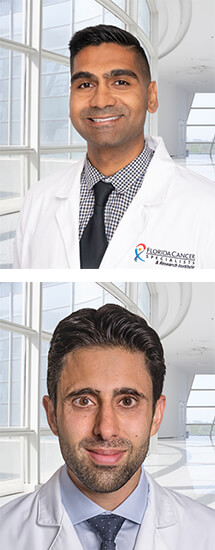Author(s): Phuoc T. Tran, MD, PhD1,2,3,4; Kathryn Lowe, BS1; Hua-Ling Tsai, PhD2; Daniel Y. Song, MD1,2,3; Arthur Y. Hung, MD5; Jason W.D. Hearn, MD6; Steven Miller, MD7; James A. Proudfoot, PhD8; Matthew P. Deek, MD1; Ryan Phillips, MD, PhD1; Tamara Lotan, MD9; Channing J. Paller, MD2,3; Catherine H. Marshall, MD2; Mark Markowski, MD, PhD2; Shirl Dipasquale, BSN1; Samuel Denmeade, MD2,3; Michael Carducci, MD2,3; Mario Eisenberger, MD2,3; Theodore L. DeWeese, MD1,2,3; Matthew Orton, MD10; Curtiland Deville, MD1; Elai Davicioni, PhD8; Stanley L. Liauw, MD11; Elisabeth I. Heath, MD7; Stephen Greco, MD1; Neil B. Desai, MD12; Daniel E. Spratt, MD13; Felix Feng, MD14; Hao Wang, PhD, MS2; Tomasz M. Beer, MD15; and Emmanuel S. Antonarakis, MD2,16
PURPOSE
We sought to investigate whether enzalutamide (ENZA), without concurrent androgen deprivation therapy, increases freedom from prostate-specific antigen (PSA) progression (FFPP) when combined with salvage radiation therapy (SRT) in men with recurrent prostate cancer after radical prostatectomy (RP).
PATIENTS AND METHODS
Men with biochemically recurrent prostate cancer after RP were enrolled into a randomized, double‐blind, phase II, placebo-controlled, multicenter study of SRT plus ENZA or placebo (ClinicalTrials.gov identifier: NCT02203695). Random assignment (1:1) was stratified by center, surgical margin status (R0 v R1), PSA before salvage treatment (PSA ≥ 0.5 v < 0.5 ng/mL), and pathologic Gleason sum (7 v 8‐10). Patients were assigned to receive either ENZA 160 mg once daily or matching placebo for 6 months. After 2 months of study drug therapy, external-beam radiation (66.6‐70.2 Gy) was administered to the prostate bed (no pelvic nodes). The primary end point was FFPP in the intention-to-treat population. Secondary end points were time to local recurrence within the radiation field, metastasis‐free survival, and safety as determined by frequency and severity of adverse events.
RESULTS
Eighty-six (86) patients were randomly assigned, with a median follow-up of 34 (range, 0-52) months. Trial arms were well balanced. The median pre-SRT PSA was 0.3 (range, 0.06-4.6) ng/mL, 56 of 86 patients (65%) had extraprostatic disease (pT3), 39 of 86 (45%) had a Gleason sum of 8-10, and 43 of 86 (50%) had positive surgical margins (R1). FFPP was significantly improved with ENZA versus placebo (hazard ratio [HR], 0.42; 95% CI, 0.19 to 0.92; P = .031), and 2-year FFPP was 84% versus 66%, respectively. Subgroup analyses demonstrated differential benefit of ENZA in men with pT3 (HR, 0.22; 95% CI, 0.07 to 0.69) versus pT2 disease (HR, 1.54; 95% CI, 0.43 to 5.47; Pinteraction = .019) and R1 (HR, 0.14; 95% CI, 0.03 to 0.64) versus R0 disease (HR, 1.00; 95% CI, 0.36 to 2.76; Pinteraction = .023). There were insufficient secondary end point events for analysis. The most common adverse events were grade 1-2 fatigue (65% ENZA v 53% placebo) and urinary frequency (40% ENZA v 49% placebo).
CONCLUSION
SRT plus ENZA monotherapy for 6 months in men with PSA-recurrent high-risk prostate cancer after RP is safe and delays PSA progression relative to SRT alone. The impact of ENZA on distant metastasis or survival is unknown at this time.
Author Affiliations
1Department of Radiation Oncology & Molecular Radiation Sciences, The Sidney Kimmel Comprehensive Cancer Center, Johns Hopkins University School of Medicine, Baltimore, MD
2Department of Medical Oncology, The Sidney Kimmel Comprehensive Cancer Center, Johns Hopkins University School of Medicine, Baltimore, MD
3The James Buchanan Brady Urological Institute and Department of Urology, Johns Hopkins University School of Medicine, Baltimore, MD
4Current address: Department of Radiation Oncology, University of Maryland, Baltimore, MD
5Department of Radiation Medicine, OHSU Knight Cancer Institute, Oregon Health & Science University, Portland, OR
6Department of Radiation Oncology, University of Michigan, Ann Arbor, MI
7Karmanos Cancer Institute, Department of Oncology, Wayne State University School of Medicine, Detroit, MI
8Veracyte, San Diego, CA
9Department of Pathology, Johns Hopkins University School of Medicine, Baltimore, MD
10Department of Radiation Oncology, Indiana University Health Arnett, Lafayette, IN
11Department of Radiation Oncology and Cellular Oncology, University of Chicago, Chicago, IL
12Department of Radiation Oncology, University of Texas Southwestern Medical Center, Dallas, TX
13Department of Radiation Oncology, University Hospitals Seidman Cancer Center, Cleveland, OH
14Departments of Medicine, Radiation Oncology and Urology, University of California San Francisco, San Francisco, CA
15OHSU Knight Cancer Institute, Oregon Health & Science University, Portland, OR
16Department of Medicine, University of Minnesota, Minneapolis, MN
